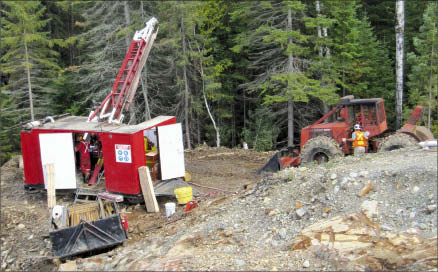When Scott McLean packed up and left Xstrata (XTA-L) after a long and fruitful career with Falconbridge, he knew exactly what he wanted to do with his time: find another world-class mine.
During his 23 years at Falconbridge – much of it spent as head of the exploration team in Sudbury – McLean won the Prospectors and Developers Association of Canada’s Prospector of the Year award in 2004 for the Nickel Rim South discovery, and he wanted more.
“You get addicted to finding world-class mines,” McLean says. “When you’ve found them before, you want to do it again.”
So he teamed up with a former colleague at Falconbridge, Kevin Stevens, and established privately held HTX Minerals in late 2007. The company holds a portfolio of nickel, copper and platinum group element projects throughout Ontario and an early-stage uranium project in the Northwest Territories.
But the public side to the former Falconbridge executive’s story only got going with the spin out
of Transition Metals (XTM-V), which completed its initial public offering in August.
Another Falconbridge alumnus, Greg Collins, joined McLean to launch Transition and serve as chief operating officer. Outside of his time at Falconbridge Collins had served as vice-president of exploration for Crowflight Minerals, now CaNickel Mining (CML-T), and helped develop the Bucko Lake nickel deposit in Manitoba.
One motivation for launching Transition was to bring liquidity to HTX shareholders, McLean says, but unlike HTX, Transition has a gold focus with six projects in Ontario and B.C.
The company is following the project-generator business model with the properties. It has already entered two joint ventures, and looks to do more.
McLean argues this model ensures that investors don’t get diluted out of their positions by equity raises, and it minimizes risk by bringing in other companies to help share the load in the inherently risky sector.
The two projects that Transition has already farmed out are Pipestone and Jumping Moose, both of which are in northern Ontario. At Pipestone the company signed a deal with Gowest Gold (GWA-V) that gives it a 40% stake in the project for $100,000 in cash, 400,000 shares and $1 million in expenditures.
At Jumping Moose the company teamed up with Spiral Exploration, now Abalor Minerals, a private company seeking a public listing which is working towards earning a 40% stake for $90,000 in cash, 500,000 shares and $1 million in expenditures.
With those two projects being tended to by Transition’s partners, the company is focusing on the Haultain project in the southern Abitibi belt along the eastern extension of the Rideout fault, which hosts such recent discoveries as Trelawney Mining‘s (TRR-V) Côté Lake deposit.
The eastern flank of the Rideout fault is less explored because of a large Proterozoic sedimentary cover that overlies the fault zone. Haultain, however, is situated within a window of prospective rock poking through the Proterozoic rock just south of the Round Lake batholith.
The company has drilled 1,800 metres in 21 holes and says it has hit upon a feeder zone of syenite dykes that are similar, McLean says, to those found at AuRico Gold‘s (AUQ-T, AUQ-N) Young-Davidson project.
Highlight intercepts from the program include 3 metres grading 4.72 grams gold, 7 metres grading 2.37 grams gold, 12 metres grading 1.57 grams gold and 0.36 metre grading 82.5 grams gold.
McLean explains that the company is focusing the bulk of its exploration efforts on three key areas at the property: the Swain swarm, the South dyke swarm and the North dyke swarm.
Within the Swain Swarm Transition has an outlined strike length of 1.2 km. Assayed gold mineralization in four trenches cut along strike in this trend boasted visible gold.
At the North Swarm Transition cut two trenches, and at the South Swarm it cut one, all revealing exposures hosting visible gold at surface.
The most recent drilling at the project was aimed at further defining the strike and depth extent of the Swain Swarm’s mineralization, and getting the first couple of intersections into showings associated with North and South Swarms.
The company is awaiting results that McLean says will help it determine whether to look for a partner or issue equity to raise capital, so that it can aggressively explore the project on its own.
Transition has $2.2 million in cash and the company is 25% held by HTX, with Transition management holding another 14%.
Over a 52-week period the company’s shares have fluctuated between 35¢ and 45¢. It has 22.1 million shares outstanding, with 29.6 million on a fully diluted basis.


Be the first to comment on "McLean’s Transition to gold"